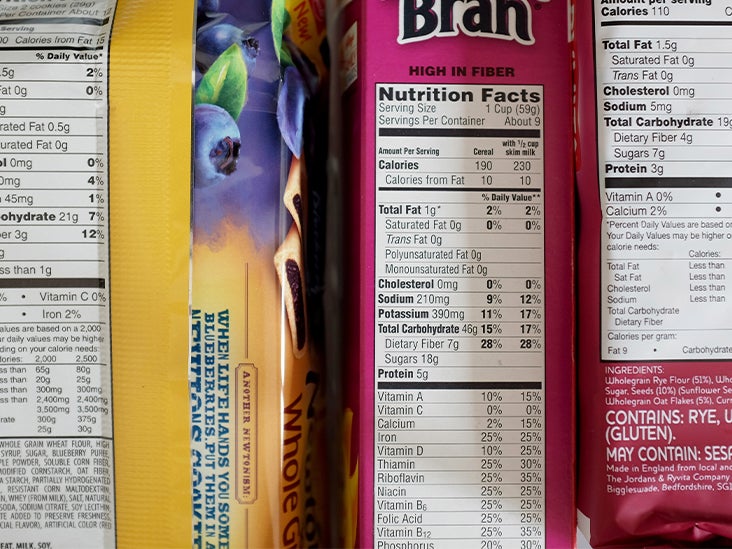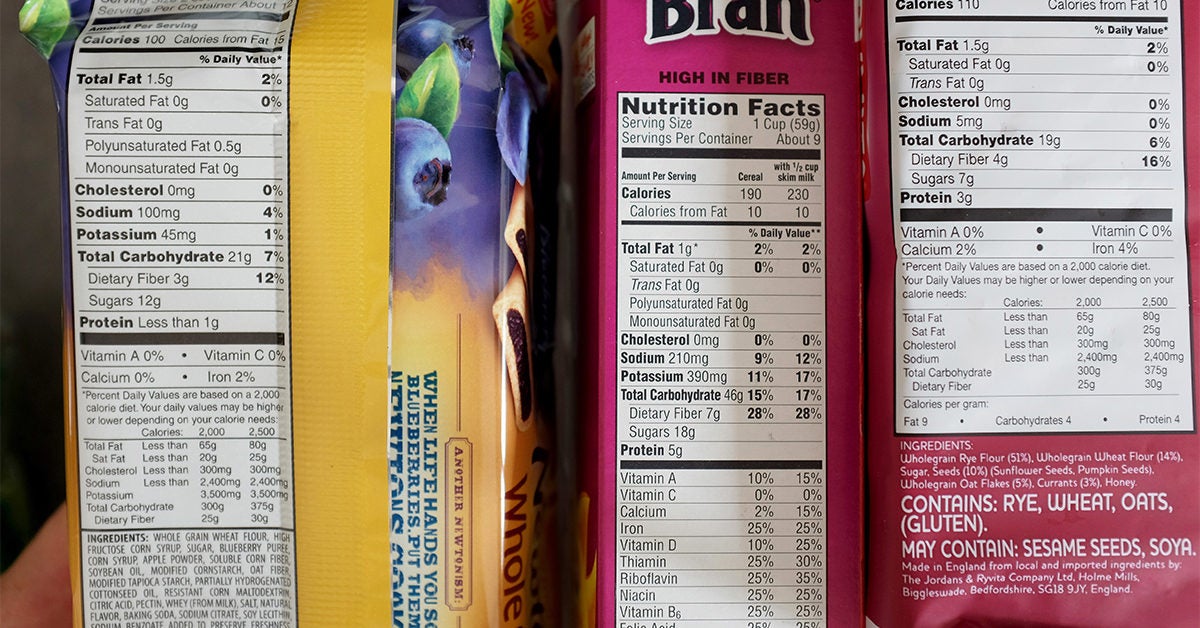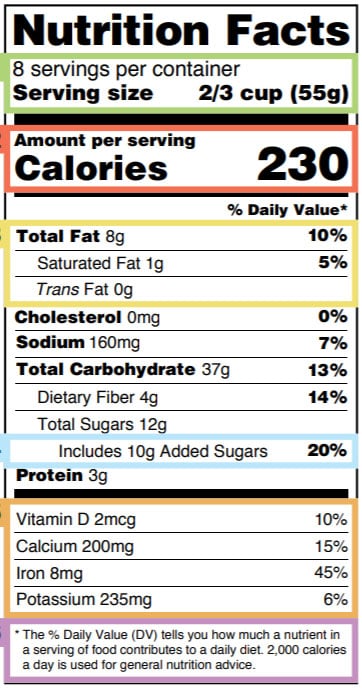41 how to read food labels sugar
How to Read a Food Label - Atkins To complicate matters still further, carbohydrates are comprised of several subgroups, which include dietary fiber, sugar, sugar alcohol and other carbohydrates—a kitchen-sink grouping of gums, lignans, organic acids and flavenoids. (These individual items can be assayed.) The FDA requires that a nutrition label include the total carbohydrates. How to Read Nutrition Facts Labels the Right Way - GoodRx Calling out total sugars and added sugars is one of the major recent changes to the Nutrition Facts label. Here's the breakdown. Total sugar. This refers to the total amount of sugar in a serving of the food. It includes both naturally occurring and added sugars. Some foods that have naturally occurring sugar include fruit and dairy products.
Understanding food labels - Action on Sugar HOW MUCH SUGAR IS IN YOUR FOOD/DRINK? Step 1 - Calculate amount of sugars per gram by dividing the amount of sugars per 100g OR 100ml by 100. Step 2 - Check the weight of a recommended portion as stated on the pack. Step 3 - Work out the amount of there is per portion by multiplying the figures from step 1 and 2.

How to read food labels sugar
How To Read Food labels for Sugar | My Sugar Free Kitchen On the label check the sugars in the nutrition panel. 5g/ml or less of sugar per 100g/ml = this would count as low sugar content. It means 5% of the ingredients are sugar Between 5g/ml and 20g/ml of sugar per 100 grams = medium sugar content. With 20ml of sugar per 100 ml, this means the product is 20% sugar…not so good. How To Read Food and Beverage Labels | National Institute ... "Best if used by" (or "best if used before") tells how long the item will have the best flavor or quality. None of these dates tell you when an item is no longer safe to eat or drink. In fact, product dates are not required by federal regulations and are added voluntarily by manufacturers. Learn more about food safety and older adults. How to read food labels - healthdirect Sugar: Sugar is a type of carbohydrate. It is better to choose healthier carbohydrates and to limit foods that are high in added sugars. Fibre: High fibre foods such as wholegrain bread and cereals improve digestion and help you to feel full. Sodium: This tells you how much salt the product contains. Eating too much salt is linked to high blood pressure and can lead to heart disease, stroke ...
How to read food labels sugar. Understanding sugar content on food labels - Diabetes Care ... Understanding sugar content on food labels is important, to ensure that you're consuming healthy amounts. Reading the ingredient lists and nutrition facts tables on packaged foods is a helpful way for you to check what kind, and how much, sugar a product has. How to Read Labels for Added Sugar | Naturally Savvy The Nutrition Facts panel will indicate the total amount of sugars, but it doesn't differentiate between naturally occurring sugar and added sugar. So, to get a better idea of how much added sugar there is requires a bit of label sleuthing. How to read food labels - Heart Foundation NZ How to read food labels. Taking a little bit of extra time to read food labels when you're shopping can have big pay-offs, but it can be hard to make sense of all those numbers. Here's a quick guide to help you navigate the supermarket and decipher food labels. Learning To Read Labels :: Diabetes Education Online On a nutrition food label, subtract the fiber from the total carbohydrate amount. When you read food labels, the grams of sugar are already included in the total carbohydrate amount, so you do not need to count this sugar amount separately. The grams of sugar listed include both natural sugars, from fruit or milk, and added sugars.
How to read labels for added sugar - That Sugar Movement Three: Remember that 4g = 1 teaspoon of sugar Technically, 4.2g = 1 teaspoon of sugar, but for the easy on-the-spot calculation, just remember 4g equals one teaspoon. For example, a 375ml can of Coca-Cola is about 40g of sugar. Dividing that by 4 means there are 10 teaspoons of added sugar in the one can. Reading Food Labels When You Have Diabetes - WebMD It has measurements of fat, cholesterol, sodium, carbohydrates, protein, vitamins, and minerals for a typical amount of that food. This information can make it easier for you to choose foods that... How to Read a Food Label to Make Sure It's Keto in 3 Easy ... Step 1. Read the Ingredient List. Food manufacturers are required by the FDA to list ingredients in order of predominance by weight. The ingredient that weighs the most is listed first, and the ingredient that weighs the least is listed last. So stay away from foods where sugar or starch is listed as one of its first 5 ingredients. That's too ... Sugars on food labels - Sugar Nutrition Resource Centre Polys or sugar alcohols are naturally found in some fruits and used commercially in products such as chewing gum. Packaged foods in Australian and New Zealand must provide nutrition information on the labels, including ingredients, nutrition information panels and content claims. Food Standards Australia New Zealand (FSANZ) are the regulatory ...
Added Sugars on the New Nutrition Facts Label | FDA Labels for foods and beverages with added sugars will list the number of grams and the percent Daily Value (%DV) for added sugars within the Nutrition Facts label. Having the word "includes" before... How to understand food labels - Eat For Health The Nutrition Information Panel on a food label offers the simplest and easiest way to choose foods with less saturated fat, salt (sodium), added sugars and kilojoules, and more fibre. It can also be used to decide how large one serve of a food group choice or discretionary food would be and whether it's worth the kilojoules. Food Labels | CDC Check the Serving size first. All the numbers on this label are for a 2/3-cup serving. This package has 8 servings. If you eat the whole thing, you are eating 8 times the amount of calories, carbs, fat, etc., shown on the label. Total Carbohydrate shows you types of carbs in the food, including sugar and fiber. How to Read a Food Label - WebMD It adds plenty of calories, and is often listed on the label in "alias" terms, like "high fructose corn syrup," "dextrose," "invert sugar," "turbinado," etc. Choose foods with less than 5 grams ...
How to Understand and Use the Nutrition Facts Label | FDA Single-ingredient sugars and syrups are labeled in this way so that it does not look like more sugars have been added to the product and to ensure that consumers have information about how a...
Reading food labels: Tips if you have diabetes - Mayo Clinic Look for foods with 3 or more grams of fiber. Put sugar-free products in their place Sugar-free doesn't mean carbohydrate-free. Sugar-free foods may play a role in your diabetes diet, but remember that it's equally important to consider carbohydrates as well. A sugar-free label means that one serving has less than 0.5 grams of sugar.
How to Read Food Labels and Understand Sugar Content | yum ... Agave, brown rice syrup, brown sugar, cane sugar, caster sugar, coconut nectar, coconut sugar, dextrose, fructose, fruit juice concentrate, glucose, glucose syrup, golden syrup, honey, icing sugar, invert sugar, maple syrup, molasses, panela, rapadura sugar, raw sugar, rice malt syrup, sucrose (They're all types of added sugar!) 'No added sugar'
Understanding food labels - Diabetes UK Check the ingredients list - if syrup, invert syrup, cane sugar, molasses or anything ending in 'ose' is within the first three ingredients, this suggests the food contains more added sugar. Choose an alternative if possible, or be mindful of the portion you eat. Check the fibre content on the back of pack label.
How to read food labels - Safefood Some labels use colour coding to show at a glance if a food is high, medium or low in fat, saturated fat, sugar and salt. If the label isn't colour coded, use our label decoder as a guide. The fibre content is important when you are looking at foods such as bread, cereals, pasta and rice.
How to Read Food Labels Without Being Tricked If you see any of these in the top spots on the ingredients lists — or several kinds throughout the list — then the product is high in added sugar. SUMMARY Sugar goes by various names — many of...
How to read food labels: MedlinePlus Medical Encyclopedia This number helps determine how foods affect your weight. The total carbs (carbohydrates) are listed in bold letters to stand out and are measured in grams (g). Sugar, starch, and dietary fiber make up the total carbs on the label. Sugar is listed separately. All of these carbs except fiber can raise your blood sugar.
Food labels - NHS Colour-coded nutritional information tells you at a glance if the food has high, medium or low amounts of fat, saturated fat, sugars and salt: red means high amber means medium green means low In short, the more green on the label, the healthier the choice.





Post a Comment for "41 how to read food labels sugar"